As an Amazon Associate I earn from qualifying purchases. Click for details.
In my book about haunted cemeteries, I mentioned ghost-hunting opportunities at unmarked graves, and at graves just outside cemetery walls.
At the time, I described many of them as the graves of people whose lives (or deaths) did not allow them to be buried in consecrated ground.
For example, a murderer is unlikely to be buried in a community cemetery.
During a recent Saturday investigation in Concord (NH), I discovered another explanation for those “outsider” graves.
The answer surprised me. It’s Quakers (also known as “Friends.”)
Quakers and unmarked graves
Apparently, between 1717 and 1850, gravestones and memorials at cemeteries were considered “vain monuments” and – according to a decree by members of the Quaker faith – had to be removed from Quaker graves.
In other words, some (perhaps many) unmarked graves aren’t anonymous because the families were too poor to afford gravestones, or because the markers were stolen, but because the burial plots belonged to Quakers.
On the other side of the fence (literally, in this case), mainstream Christians objected to members of the Friends Church (or Religious Society of Friends) – generally known as “Quakers” – being buried in consecrated ground.
This was because Quakers aren’t baptized, or – in Quaker terms – “sprinkled.”
This adds up to a disturbing thought, though it may explain why some homes and fields seem haunted, with no obvious explanation:
Some Quakers may have been buried in fields, and family plots – also unmarked – near their homes. In other words, you may have walked over Quaker graves many times without realizing it.
Old North Cemetery, Concord, NH
I discovered this during some post-investigation research about the Old North Cemetery in Concord, New Hampshire. I’d been there with Lesley Marden and Sean Paradis, and we spent about two and a half hours researching the site.
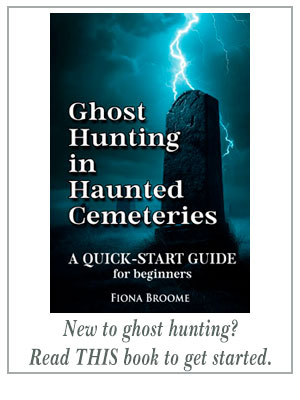 Sean and I had been there before, and I’d investigated the cemetery on my own, during daytime hours. (It’s on the edge of downtown Concord, in the middle of a busy residential area.)
Sean and I had been there before, and I’d investigated the cemetery on my own, during daytime hours. (It’s on the edge of downtown Concord, in the middle of a busy residential area.)
Though the site may be haunted after dark, and we noticed many anomalies at the cemetery, I don’t consider Old North Cemetery profoundly haunted. It is intriguing, nevertheless.
The cemetery is L-shaped and covers nearly six acres and – according to the National Historic Register application – it’s comprised of three areas: The main cemetery, the Minot Enclosure (sort of a cemetery-within-a-cemetery), and the Quaker Lot. (That’s not quite true, as I’ll explain in a few minutes.)
The cemetery was in most frequent use between 1730 and 1958.
The Quaker Lot
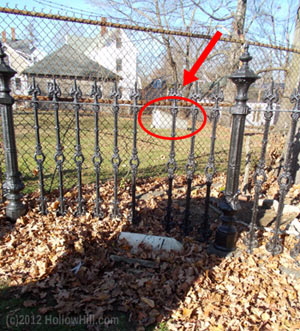 Though I’d been to Old North Cemetery before, I hadn’t noticed the odd, open field in the back of the Minot Enclosure. That field has just a few markers, and one of them reminded us of a bunker marker.
Though I’d been to Old North Cemetery before, I hadn’t noticed the odd, open field in the back of the Minot Enclosure. That field has just a few markers, and one of them reminded us of a bunker marker.
The arrow indicates it, and the Friends’ (Quaker) marker is in the oval. That part of the cemetery is separated from the Minot Enclosure by a cast iron fence (with a break in it) and a chain-link fence topped with barbed wire.
To reach the Quaker burial lot, you’ll exit Minot and walk through the main Old North Cemetery, to where the Quaker Lot begins. (It’s not fenced off from the main cemetery.)
Once you’re standing in what looks like an open field, about 10,000 square feet, you’ll see just a few markers. The main one is the slanted memorial listing many of the people buried in the Quaker Lot. The lot was purchased in 1811, according to the terms of the will of Benjamin Hannaford. He’s one of the people buried in the lot.
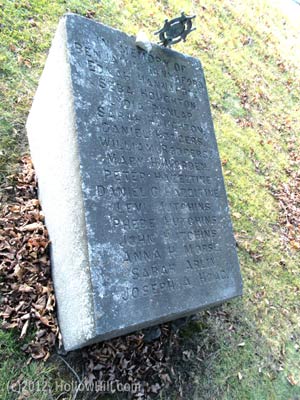 The memorial marker is on the left. (Due to the late afternoon lighting, I had to increase the contrast in this photo so that the lettering would show.)
The memorial marker is on the left. (Due to the late afternoon lighting, I had to increase the contrast in this photo so that the lettering would show.)
At the back of that memorial, you can see a metal marker for Levi Hutchins. I think it’s a military marker, and it’s just sort of leaning there. No one knows where Levi Hutchins was buried, so there’s no actual place for the marker.
On the other hand, Levi Hutchins’ wife, Phebe, does have a gravestone. Levi defied Quaker traditions and commissioned a headstone for his late wife. That’s it in the photo at the lower right.
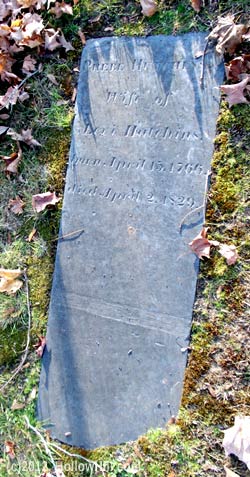 The history of the Quakers in Concord is an interesting story.
The history of the Quakers in Concord is an interesting story.
The part that caught my attention was that the Friends (Quakers) built a meetinghouse in 1815, but in 1816, the state bought the land from them (it’s where the Concord State House is now). The city moved the meetinghouse to a location just east of the Quaker burial lot, fronting on North State Street. (Sean, Lesley, and I had wondered about the odd landmarks on the property.)
In those days, that was the edge of the city.
In 1845, the meetinghouse was sold and moved again, to become a school building. The land it was on was purchased by the city in 1911 for the sum of $300 because it was “in a very bad condition and a disgrace to our city.”
That’s an added reason why the Quaker Lot (and land near it) may be more active than other parts of the Old North Cemetery.
And, from the popular, gated entrance to the cemetery at Bradley Street, the Quaker Lot is – as you might expect – at the back left corner.
Quaker-related activity at Minot Enclosure?
We spent considerable time at the Minot Enclosure, an exclusive section of the Old North Cemetery, surrounded by an elaborate cast iron fence and containing 62 graves. There, we noticed that random gravestones had been turned so they faced slightly away from the Quaker Lot.
Those random and very slight turns weren’t consistent with vandalism. That was one of many mysteries we wondered about as we walked around the cemetery.
Now that we know about the Quaker Lot, Sean Paradis has raised an interesting question:
The Quakers in the Quaker Lot are from a time when gravestones were considered “vain monuments.” Just feet away, the 14th U.S. president, Franklin Pierce, is buried in the Minot Enclosure. Might the activity within the Minot Enclosure be based on the mutual uneasiness of the Quakers and the upper social register in the Minot Enclosure?
That’s a stretch, but it’s fun to speculate.
However, as I was studying the cemetery records, I realized that Old North Cemetery isn’t just a combination of three cemeteries. I discovered a fourth section of the cemetery, not often mentioned.
The Prison Lot
 According to the National Historic Register application, “The Prison Lot, comprised of a long 10′ x 75′ rectangular lot just west of lots #384 and #385 in the center of the cemetery, appears on all maps drawn after the 1844 western addition to Old North Cemetery.”
According to the National Historic Register application, “The Prison Lot, comprised of a long 10′ x 75′ rectangular lot just west of lots #384 and #385 in the center of the cemetery, appears on all maps drawn after the 1844 western addition to Old North Cemetery.”
The report also states that the cemetery records note at least a dozen graves there, but there are no records of the names of the deceased in those graves.
And, since the old State Prison – built in 1811 – was replaced in 1880, there’s probably no way to determine who might be in those graves. (The photo on the left shows that 1811 prison, on two acres near the Court House. It was attached to a three-story superintendent’s house.)
Unmarked graves + prisoners + no records of any kind to tell us who they were… That’s a formula for hauntings. (If anyone’s giving “ghost tours” of downtown Concord, NH, take note.)
If you’re going to investigate those graves, be sure to check the chronological history of the NH State Prison.
In general, if you’re going to visit or investigate Old North Cemetery, I recommend reading the full National Historic Register application, which is linked below.
(Note: I’ve tried downloading it three times, and it consistently crashes my Adobe PDF reader. If that happens to you, notice which page you’re on when it crashes, and then use the “go to” page function when you reopen the PDF, to pick up where you left off.)
Both the main cemetery and the Minot Enclosure deserve separate articles, which I’ll write later. Today, it’s important to share what I learned about Quaker burial practices. Remember, as one history of the Society of Friends says, “By 1700, the Society gained considerable influence in most of the New England and middle-Atlantic colonies. Quaker migration to the southern colonies, especially North Carolina…”
In other words, unmarked Quaker graves—and even unmarked (and forgotten) Quaker burial lots—may exist throughout the eastern United States, Ohio, Indiana, Illinois, and Canada.
What you need to know about all Quaker graves and burial lots
- Expect no grave markers for burials before the late 1840s.
- Quaker graves could be in Quaker burial grounds, near the person’s home, at the far corner of a family farm or homestead, or in a rural location. I found one reference that said Quakers “always regarded the physical remains of a person as spiritually insignificant.”
- The burial was intended to be as inexpensive as possible, within the law. One Quaker historian commented, “Well into the 20th century, it was not unusual for a country burial to have an unembalmed body.”
- In some Quaker cemeteries, especially before 1850, coffins were placed in the first available slot in the cemetery, not in family groups. Philadelphia’s Arch Street burial ground (between Third and Fourth Streets), in use until 1804, was organized so the coffins were four layers deep, and none had markers of any kind.
- Despite rumors and folklore, I found no evidence of Friends (or Quakers) being buried upright. There was no rule against that practice, but there was no provision for it, either.
- In the 20th century and later, Quakers generally chose cremation.
Quaker beliefs about death
I’ll let William Penn have the final word about the Friends’ (Quakers) attitude towards death. This is from a poem published in 1693:
And this is the Comfort of the Good,
that the grave cannot hold them,
and that they live as soon as they die.
For Death is no more
than a turning of us over from time to eternity.
References
Old North Cemetery, Concord, NH – National Historic Site application (PDF)
Fox’s Pulpit Quaker burial ground, Sedbergh, Cumbria
Quaker Burial Practices, at Quaker-Roots-L
Burial Practices of Quakers, at Genealogy.com
The Buried Past: An Archaeological History of Philadelphia, by John L. Cotter, Daniel G. Roberts, Michael Parrington, page 200
Quaker Funeral Arrangements, by Oxford Quakers
Society of Friends (Quakers) in the United States, at FamilySearch.org (LDS)
My YouTube channel includes this and many other how-to videos:

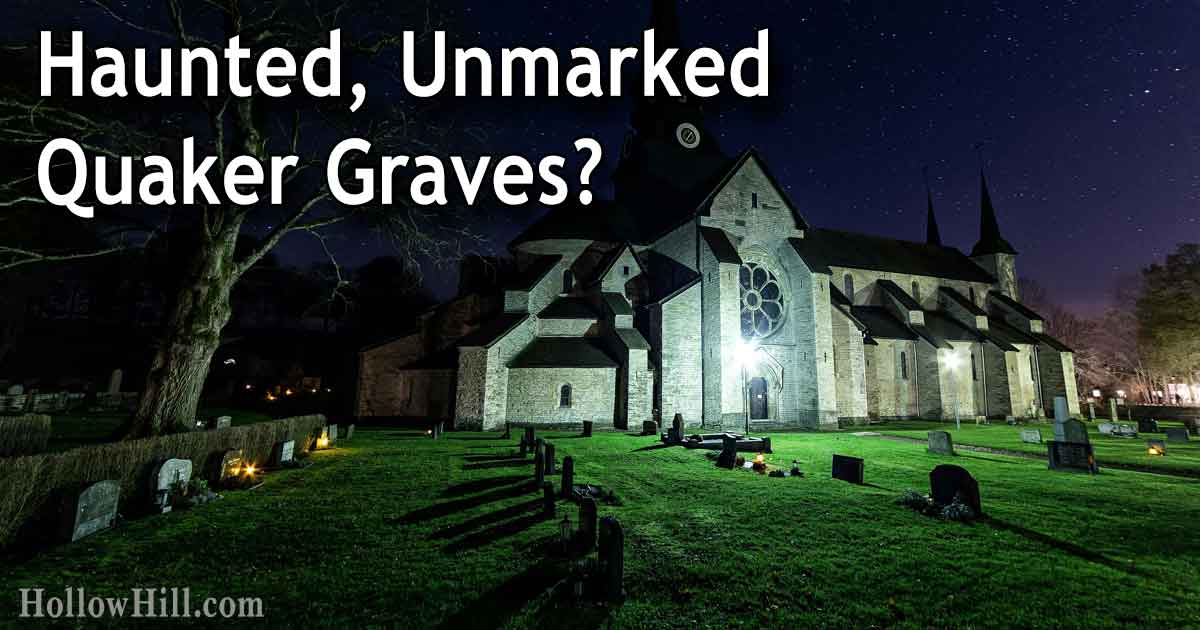
Hi,
I was googling old north end cemetery earlier today when I found your website. I was waiting for my husband with my boys and had some time to kill and it was literally 2mins away, I am a believer in the paranormal but I also enjoy exploring new places. Well I decided to take a few pics of graves I thought were pretty or interesting then I tried to do an evp just to see what might happen. I got in the car plugged it in and listened to all three I did two I could hear anything but one about 9secs in I hear something that stands out above the wind and everything. I had my husband listen who is a non believer and even he admits he hears something we just cant understand what it says. I’d like to get a second a opinion if its wind or what it might be. If you’d like to hear it plz let me know. Thank you